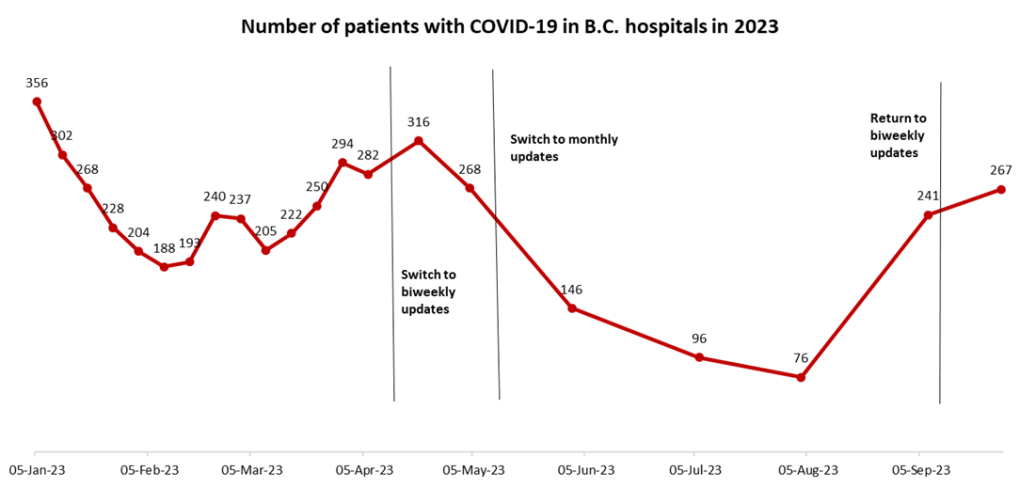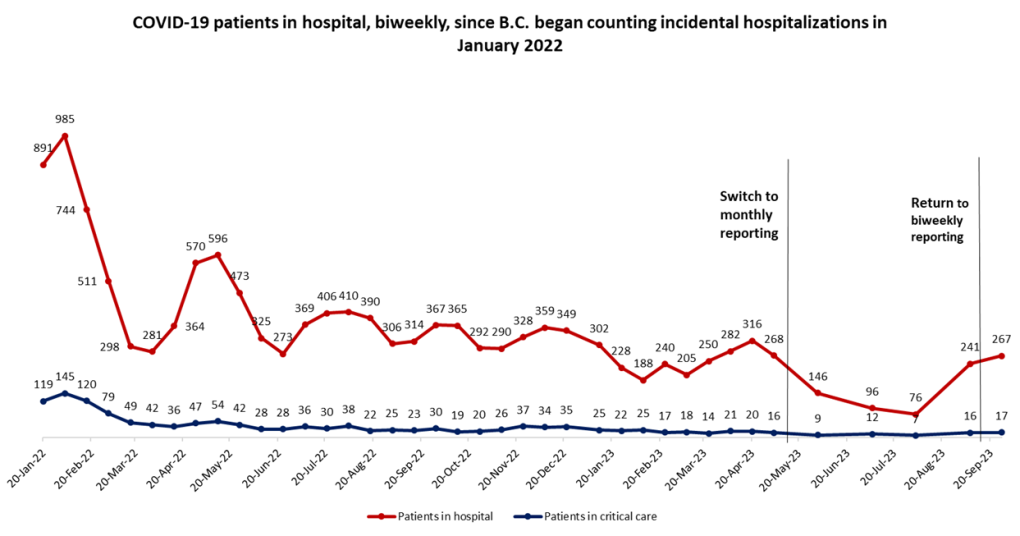267 in hospital with COVID-19 as BCCDC returns to biweekly data updates
 A sign at the BC Centre for Disease Control is seen in this photo from the BCCDC website.
A sign at the BC Centre for Disease Control is seen in this photo from the BCCDC website.
After publishing COVID-19 data just once a month over the summer, the B.C. Centre for Disease Control returned to biweekly updates this week.
The number of people in hospital with the coronavirus on Thursday was 267, a relatively modest 12-per-cent increase from the 241 reported in the last BCCDC update on Sept. 7.
The increase in the hospitalized population in this week's update is much smaller than the more-than-tripling the data showed between the BCCDC's August and September updates.
 The number of people in hospital in each BCCDC COVID-19 update in 2023 so far. (CTV)
The number of people in hospital in each BCCDC COVID-19 update in 2023 so far. (CTV)
The BCCDC considers the number of people in hospital with COVID-19 at any given to be an overestimate of the burden of the coronavirus in the provincial health-care system, because it includes both those who were hospitalized because of serious cases of the virus and those who were hospitalized for other reasons and tested positive after admission.
Since the province started including these "incidental" cases in its hospitalization total back in January 2022, the BCCDC has reported as many as 985 people in hospital with COVID-19 in one of its updates, and as few as 76.
That low point came less than two months ago, on Aug. 3 of this year.
 The number of people in hospital with COVID-19 as reported by the BCCDC biweekly since January 2022. (CTV)
The number of people in hospital with COVID-19 as reported by the BCCDC biweekly since January 2022. (CTV)
It should also be noted that – though the BCCDC considers its count of people currently in hospital to be an overestimate of virus severity – data from the Canadian Institute for Health Information showed thousands more hospital discharges for COVID-19 in the province during the 2022-23 fiscal year than the BCCDC reported admissions for the same period.
While the two agencies are measuring different things, the BCCDC did seem to acknowledge that CIHI's numbers are more complete than its own in a statement to CTV News last month.
Regardless of the many caveats that come with all COVID data, the trend in recent months is clear: Transmission has been increasing.
Other BCCDC metrics, such as new hospital admissions and new infection episodes, have shown an increase in the latest update.
There were 178 new hospitalizations from Sept. 10 to 16, the most recent Sunday-to-Saturday "epidemiological week" reported by the BCCDC. That's an increase from 161 during the preceding period, and it's a figure that's likely to be revised upwards in future reports as data become more complete.
Likewise, there were 628 new infection episodes confirmed through lab-based testing during the week of Sept. 10 to 16, up from 425 the week before.
While testing is limited and not meant to capture every new COVID-19 infection that occurs in B.C., the percentage of tests coming back positive has also grown in recent weeks.
The BCCDC reported a test-positivity rate of 20.8 per cent for the week ending Sept. 16, the highest rate seen in more than a year.
Wastewater surveillance – which can be used to approximate transmission of the SARS-CoV-2 virus not captured by testing – tells a similar story.
As has been the case for the last several weeks, treatment plants in the Lower Mainland saw increasing virus concentrations during recent epidemiological weeks.
Elsewhere in the province, the most recent data is a mixed bag, with increasing concentrations seen in Kelowna, Victoria and the Comox Valley, but declining concentrations in Kamloops, Penticton and Nanaimo.
CTVNews.ca Top Stories

BREAKING Ontario Premier Doug Ford threatens to cut off energy to U.S. in response to Trump's tariffs
Ontario Premier Doug Ford has threatened to cut off energy supply to the U.S. in response to the tariffs President-elect Donald Trump plans to impose on all Canadian imports.
Elon Musk calls Justin Trudeau 'insufferable tool' in new social media post
Billionaire Elon Musk is calling Prime Minister Justin Trudeau 'an insufferable tool' in a new social media post on Wednesday. 'Won't be in power for much longer,' Musk also wrote about the prime minister on 'X.'
Trudeau will have to 'kiss the ring' to achieve smoother bilateral relations with Trump: John Bolton
If Prime Minister Justin Trudeau wants to get on U.S. president-elect Donald Trump's good side for the sake of a smooth bilateral relationship, he'll likely have to be openly deferential, says former U.S. National Security Advisor, John Bolton.
Toronto agency launches court challenge against new law that would shutter some supervised consumption sites
A social agency that runs a supervised consumption service (SCS) in Toronto’s Kensington Market has launched a court challenge against new legislation that will see 10 such sites shuttered across the province, arguing that the law violates the Charter of Rights and Freedoms.
MAID cases rose to 15,000 in 2023, but growth of cases halved
More than 15,000 people received medical assistance in dying in Canada in 2023, but federal statistics show the growth in cases has slowed significantly.
Luxury real estate brokers charged in federal indictment with sex trafficking in NYC
Two luxury real estate brokers and their brother have been charged with luring, drugging and violently raping dozens of women over more than a decade.
Police locate labyrinth of tunnels connecting tents to generator in Hamilton encampment
Hamilton police say that they discovered a series of 'man-made holes and tunnels' during a patrol of a downtown encampment earlier this week.
Certain foods may disrupt your body's fight against cancer cells, study says
The food you eat may be affecting your body’s ability to fight cancer cells in the colon, according to a new study.
Banks lower prime rates following Bank of Canada move
Canadian financial institutions are lowering their prime lending rates to match the decrease announced by the Bank of Canada.

































